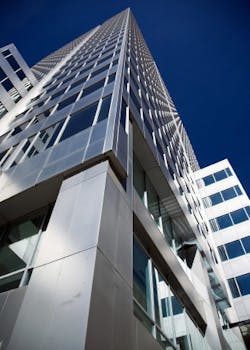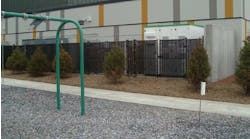The ability to accurately measure and compare the energy use of commercial buildings is critical to improving their performance and increasing standards of efficiency. The compilation of performance data for the purposes of comparison and analysis will ensure new benchmarks. Recent building codes, such as the 2012 International Energy Conservation Code (IECC) are aiming to increase energy efficiency in new buildings by 30% over the 2006 edition and 17% over the 2009 edition. In addition, policies, such as the Better Buildings Initiative are prompting partners in the private and public sectors to make America’s buildings 20% more efficient over the next decade. Therefore, data collection is proving vital to gauging baselines of energy consumption and establishing benchmarks.
A study released last November by NBI and developed jointly with Ecotope, Seattle, summarizes the extent to which operations and occupant behavior impact a building’s energy use compared to design characteristics. “Sensitivity Analysis: Comparing the Impact of Design, Operation, and Tenant Behavior on Building Energy Performance” also makes recommendations for design teams, owners, and operators on what they can do to ensure the full potential for energy savings from efficiency measures is realized — and provides a broad perspective on how buildings use energy and what aspects of building energy performance deserve more attention in design, operation, and policy strategies. Most significantly, the study suggests that although the market generally assigns responsibility for building energy performance to the design team for aspects such as envelope, HVAC system, and lighting system features, operational and tenant practices have a significant impact on building energy use.
For example, decisions about the efficiency levels of the lighting and controls systems are fully under the purview of the designers, according to the report, but the ultimate effectiveness of the lighting controls is more in the hands of building operators and occupants. “The perception that energy performance is relatively set once the building is designed and constructed is not valid,” explained NBI Technical Director Mark Frankel, an author of the report. “In fact, a significant percentage of building energy use is driven directly by operational and occupant habits that are completely independent of building design, and, in many cases, these post-design characteristics can have a larger impact on total energy use than many common variations in the design of the building itself.”
Therefore, while computer modeling of buildings built to the 2012 IECC shows on average more than 30% better energy efficiency than those built to the ASHRAE 90.1-2004 model code, the real-world performance of the buildings (once they’re built and occupied) may not meet that level. The effect of occupant behavior, in particular, on energy use is difficult to predict. Despite being built to correct specifications, buildings may not perform as well as their modeled estimates because of end-users’ unpredictable energy use. As a result, the new code contains language requiring proof of commissioning once the certificate of occupancy is issued, which may also be used for compliance reporting after building occupancy.
An Explosion of Data
“There’s definitely going to be a lot of measurement and verification of energy efficiency savings as a result of these national energy efficiency targets,” says Eric Bloom, senior research analyst contributing to Pike Research’s smart buildings practice with a focus on building systems, high-efficiency lighting and controls, and energy-efficient building design, construction, and operations. According to one of the firm’s recent reports, advances in technology and the availability of much more detailed data and information on how buildings can use energy more efficiently have sparked growing interest in, and rising sales of, building energy management systems (BEMS).
Pike Research estimates worldwide revenue from BEMS, with North America leading the market, will increase at a compound annual growth rate of nearly 14% through the rest of this decade, reaching just under $6 billion a year by 2020. “The BEMS market is evolving rapidly and is enjoying a burst of innovation, leading to an explosion in the amount of data that is available on the energy performance of commercial buildings,” says Bloom, who points to the ability of BEMS to benchmark buildings’ energy use, efficient or inefficient, according to the prevailing average energy cost per square foot. “Just knowing how a building performs — and how it performs to comparable buildings — is a huge benefit in which few companies or building owners invested in the past.”
In an additional report, Pike Research reveals that the market for the commercial building automation systems (BAS) is in the midst of revolutionary change in terms of technology and relevance to building energy management. From the 1970s until the mid-1990s, modern building automation consisted of individual systems, or silos, with simple control panels for switches, timers, and alarms. New systems, however, are designed to perform complex tasks and play a more central role in efficiency. Overall, the market for commercial BAS is expected to double over the next decade, increasing from $72.5 billion in 2011 to $146.4 billion by 2021.
Because commercial buildings consume roughly 23% of all electricity globally, the automation systems that improve, measure, and verify efficiency are a critical part of global energy management, concludes the report. “Software systems are being developed to listen in on data being produced by BAS and other sensors in buildings and using that data to tell the right people within an organization — be it the CEO, CFO, or facility manager — about how energy is being used in their buildings and how energy can be used better in their buildings,” says Bloom. “It’s really about the evolution of the technology itself.”
According to Bloom, five years ago, there were no software systems that provided that type and amount of information. “There weren’t that many buildings that had sophisticated enough building automation systems with digital controls that could actually feed this kind of information into any kind of software platform,” says Bloom. “Today, there’s more of a critical mass of buildings being built, and new buildings are much more intelligent than buildings built 10 years ago.”
Integrating software with those systems allows building owners to get insight into how energy is being used. “As a result of the advance in technology, what’s really happening is that energy is being transformed from basically an inevitable cost of doing business to something that can actually be managed,” says Bloom. “More than anything else, it’s just the availability of such a system.”
However, despite significant growth and much publicity, the green construction and technology market still accounts for only a small percentage of the existing commercial building stock. Newer buildings built within the last 10 years may contain digital controls that can be updated. But older buildings, which may contain pneumatic or analog controls, are out of the market for installation of these types of energy management systems. “What you can do for an older building is replace old chillers or other HVAC equipment with more efficient equipment,” says Bloom. “The payback, depending on how old and inefficient the building is, can be pretty strong.” Yet, these buildings still need an energy use benchmark.
There Can be Only One
Since 1979, the U.S. Energy Information Administration’s (EIA) Office of Energy Consumption and Efficiency Statistics has been compiling and publishing the results of its national sample survey, the Commercial Buildings Energy Consumption Survey (CBECS), which it conducts every three to four years. The results provide the only national-level source of data on the characteristics and energy use of the existing stock of commercial buildings in the United States. “CBECS is meant to be a snapshot in time of what was going on in commercial buildings during the reference year of the survey,” says Joelle Michaels, CBECS survey manager. “It represents commercial building stock as a whole.”
The survey process includes an advance package of materials (including worksheets) that is provided to the building owner or operations contact a few days before the interview is conducted. The interview, usually conducted in-person by a professional interviewer using a computerized survey instrument programmed in-house by EIA using a survey processing language, covers many topics, including building size and use; ownership and occupancy; energy sources, uses, and equipment; and
energy consumption and cost. The average interview lasts around 30 minutes.
“There are questions about the building itself,” says Michaels. “Those set up general questions about the building, and then we get more technical and more energy related.”
The questions differ depending on building size, type, and use. “A huge hospital is going to have a much more complex interview than a corner store that basically is more residential in its systems,” says Michaels. “A small building will have different questions versus a huge building with multiple systems. It varies widely.”
In addition, the interviewer tries to get to the best source of information about the building and its energy use. “We contact the building owner, the building manager, the operations lead, or the energy engineer,” says Michaels. “The type of information we get varies a lot by the type of person, so we’re looking for the person who is knowledgeable about the energy use in the building. Ideally, if you have an operations and maintenance person, that’s your best respondent.”
If energy usage information is not available or if there are questions about the data provided, the building survey is followed up with an energy supplier survey. “If they can’t provide the information or if it seems incorrect, we have some edit checks built into our instrument just to make sure the figures seem reasonable,” says Michaels. “We ask them to sign an authorization form, and we’ll go to their energy supplier.”
Energy suppliers are consulted for about half of the CBECS buildings. Historically, the sample size totaled between 5,000 and 7,000 buildings. Unfortunately, due to budget issues, the database is missing the data from last two information-gathering cycles. In 2007, in an effort to save money, EIA contracted out the interview process. After reviewing the data, the office determined the CBECS 2007 data did not meet EIA standards for quality, credible energy information. As a result, EIA will not publish complete data tables from CBECS 2007 or release a public use file. “There was somewhat of an experimental approach used to update our frame for buildings — the list of buildings from which we will select buildings to interview — that were constructed,” says Michaels.
EIA expected to save 30% of the usual survey cost, which equated to a few million dollars. “We’ve learned that we cannot cut corners on this survey,” said Tom Leckey, director, Office of Consumption and Efficiency Statistics at EIA, in a press release accompanying the announcement that the results would not be published. “It delivered on the lower costs, but it did not deliver on the validity of the sample.”
Then, in 2011, the survey was suspended as a result of budgetary cuts by Congress, which cut EIA’s funding by 14%. Due to these setbacks, the latest available data dates back to 2003, forcing the programs that rely on it to date back almost a decade. For example, an office within EIA uses the data for its 30-year long-term energy use forecast. In addition, the U.S. Environmental Protection Agency’s (EPA) Energy Star uses the CBECS data as an essential input into its Target Finder program, a no-cost online tool that enables architects and building owners to set energy targets and receive an EPA energy performance score for projects during the design process. Projects that earn a score of 75 or higher are eligible for certification and can be submitted for the Energy Star Challenge. USGBC’s Building Performance Partnership (BPP) relies on CBECS data for the commercial sector, along with WegoWise for multifamily residential.
“There’s been a 10-year gap in the CBECS,” says Bloom. “Overall, business has become much more of an energy-intensive process, so companies are using more energy and, therefore, stand to benefit more from investments in energy-efficient technology. Now information technology (IT) uses so much more space in commercial buildings than it had in the past, and IT is obviously very energy intensive.”
There are alternatives to CBECS. California customers have access to the California End Use Survey (CEUS), which has benchmarked 2,700 buildings. Gridium benchmarks with both CBECS and CEUS for California customers. ASTM BEP offers a standardized process for benchmarking. The National Institute for Building Science (NIBS) has proposed a High-Performance Building Data Collection Initiative, which NBI supports, as a path forward for collecting and disseminating data. The Green Building Alliance — now in consort with the American Society of Heating, Refrigerating and Air-Conditioning Engineers (ASHRAE) — has been working for several years to develop its Database for Analyzing Sustainable and High Performance Buildings (DASH), a publicly available collection of data about building operation, maintenance, and performance, especially for green, sustainable, and high-performance buildings. Additionally, owners of multiple buildings can perform internal benchmarking, or they can arrange to trade data with owners of other buildings.
However, EIA has resumed preparations to conduct the next CBECS, with plans to field the survey between April and September 2013, with the energy supplier survey following. “We’re finalizing our questionnaire right now and working on the sampling frame,” says Michaels. “So we’re doing all that right now in preparation to go into the field and do the survey in April. We’re deep into the development of the survey.”
The interviewers will collect data for reference year 2012. EIA expects to publish the first results of the survey in the first half of fiscal year 2014.
EIA will provide regular project status reports to the public throughout the course of the project. To safeguard the integrity of the data, EIA’s status reports for CBECS 2012 will report on risk mitigation strategies undertaken to assure the delivery of the data. “For 2012, we’re returning to more tried-and-true methods of updating the sampling frame that we are confident will provide accurate and reliable results,” says Michaels.
Yet, there will be some changes for 2012. The sample size will be increased by 150%, meaning the target number of buildings for 2012 is around 8,500 buildings. In addition, a subset of buildings will be re-interviewed/verified using energy audit techniques. Finally, some interviews will be conducted by telephone in order to locate more knowledgeable respondents.
On May 15, USGBC hosted the 2012 CBECS Stakeholder Meeting. About 20 participants attended in-person and another 40 or 50 participants virtually attended via webinar, representing a variety of industries — including government, trade associations, real estate, energy consultants, advocacy groups, architects, engineers, laboratories, and equipment manufacturers. EIA presented its planned changes to the 2012 CBECS questionnaire and took comments from the audience on each section. “We have very extensive meetings with our stakeholders and got a lot of input on changes we should make and new questions we should ask,” says Michaels. “So we are revising the questionnaire quite a bit to keep it relevant.”
Still, Michaels speculates that some gains in energy efficiency will prove to be offset by increased energy use in commercial buildings. “You’ll have existing buildings that aren’t part of these energy-efficient initiatives,” says Michaels. “So I’m not sure whether we’ll see dramatic results or not.”
According to Michaels, in addition to all the energy-saving policies and initiatives that have been implemented, there’s also a lot more energy use occurring in buildings. “There are a lot more computers,” she continues. “End-use has gotten more intensive at the same time as buildings have become more energy efficient, so those measures cancel each other out.”




